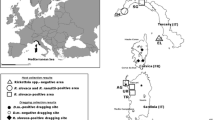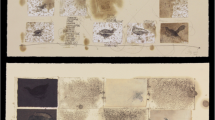Abstract
Ticks play important roles as vectors and sometimes as reservoirs in the ecology of rickettsiae. The obligate association between ticks and rickettsiae has been elucidated in studies concerning the maintenance of rickettsiae in ticks, agent dissemination in various tick organs, rickettsial developmental cycles in the tick organism, transfer among various developmental stages in tick hosts, the effect of rickettsiae on the tick organism, the interaction between microorganisms other than rickettsiae and rickettsiae is a tick body, as well as the release of rickettsiae from ticks into the environment.
Similar content being viewed by others
References
AeschlimannA., BurgdorferW., MatileH., PeterO. and WylerR. (1979): Aspect nouveaux du rôle de vecteur joué par Ixodes ricinus L. en Suisse. Note préliminaire. — Acta trop. 36: 181–191.
BalashovYu. S. and DaiterA.B. (1969): Intensivity of gas exchange in Hyalomma asiaticum P. Sch. et E. Schl. infected with the rickettsiae Coxiella burneti and Dermatoxenus sibiricus. — Parazitologia 3: 12–16.
BalashovYu. S. and Daiter A.B. (1973): Haematophagous arthropods and rickettsiae. — Ed. Nauka, Leningrad, p. 1–249.
BalashovYu. S., DaiterA.B. and StanyukovichA.K. (1969): The effect of infestation with the rickettsia Coxiella burneti and Dermatoxenus sibiricus on the content of free amino acids in the tick Hyalomma asiaticum. — Parazitologia 3: 281–285.
BrintonL.P. and BurgdorferW. (1971): Fine structure of Rickettsia canada in tissues of Dermacentor andersoni Stiles. — J. Bact. 105: 1149–1159.
BurgdorferW. (1963): Investigation of “transovarial transmission” of Rickettsia rickettsii in the wood tick, D. andersoni. — Exptl. Parasitol. 14: 152–159.
BurgdorferW. (1970): Worldwide research on human and animal diseases caused by tick borne rickettsiae. — Misc. Publ. Entom. Soc. Amer. 6: 339–344.
BurgdorferW. (1980): The spotted fever group disease. CRC Handbook Series in Zoonoses, J.H. Steele — ed., 2, CRC Press, Boca Raton, Florida, p. 279–301.
Burgdorfer W. and BrintonL.P. (1975): Mechanisms of transovarial infection of spotted fever rickettsiae in ticks. — Ann. N.Y. Acad. Sci. 266: 61–72.
Burgdorfer W., Hayes S.P. and Mavros A.J. (1981): Nonpathogenic rickettsiae in Dermacentor andersoni: A limiting factor for the distribution of Rickettsia rickettsii. — In: Rickettsiae and Rickettsial Diseases. —Academic Press. p. 585–594.
BurgdorferW. and OrmsbeeR.A. (1968): Development of Rickettsia prowazeki in certain species of ixodid ticks. — Acta virol. 12: 36–40.
BurgdorferW., OrmsbeeR.A. and HoogstraalH. (1972): Ticks as vectors of Rickettsia prowazeki a controversial issue. — Amer. J. Trop. Med. Hyg. 21: 989–998.
DaiterA.B. (1977): Transovarial and transspermal transmission of Coxiella burneti by the tick Hyalomma asiaticum and its part in the ecology of Q rickettsiosis. — Parazitologia 11: 403–411.
DaiterA.B. (1979): The ticks Hyalomma asiaticum and Ornithodoros papillipes at the single and combined infection with Coxiella burnetii and Dermacentroxenus sibiricus. — Parazitologia 13: 8–18.
DaiterA.B. (1985): Effect of some biotical factors on the infection of ixodid ticks with C. burnetii 2. Importance in strain differences on effective tick infection. — Med. par. par. bol. 4: 68–72.
DaiterA.B. (1985): Effect of some biotical factors on the infection of ixodid ticks with C. burnetii 1. Importance of blood feeding period for establishment of the infection. — Med. par. par. bol. 3: 17–20.
DiehlA.P., Řeháček J. and BázlikováM. (1980): The ultrastructure of Rickettsia slovaca in naturally infected females of the tick Dermacentor marginatus. — Ann. Parasit. 55: 259–270.
HayesS.F. and BurgdorferW. (1979): Ultrastructure of Rickettsia rhipicephali, a new member of the spotted fever group rickettsiae in tissues of the host vector Rhipicephalus sanguineus. — J. Bacteriol. 137: 605–613.
HayesS.F. and BurgdorferW. (1982): Reactivation of Rickettsia rickettsii in Dermacentor andersoni ticks: an ultrastructural analysis. — Infect. Immun. 37:779–785.
HayesS.F., BurgdorferW. and AeschlimannA. (1980): Sexual transmission of spotted fever group rickettsiae by infected male ticks: Detection of rickettsiae in inmature spermatozoa of Ixodes ricinus. — Infect. Immun. 27: 638–642.
KokorinI.N., SidorovY.E. and GudimaO.S. (1969): Some peculiarities of the development of rickettsiae in ticks. — Parazitologia 3: 193–196.
KryuchechnikovY.N. and SidorovY.E. (1969): The distribution of Dermacentroxenus sibiricus in the organism of Dermacentor marginatus Sulz. in different stages of its development. — Parazitologia 3: 110–114.
ŘeháčekJ. (1984): Rickettsia slovaca, the organism and its ecology. — Acta Scient. Nat. Acad. Scient. Bohemoslovacae Brno 18: 1–50.
ŘeháčekJ. and BrezinaR. (1968): Detection of Coxiella burnetii in saliva of experimentally infected ticks, Hyalomma dromedarii Koch. — Bull. Wld. Hlth. Org. 39: 974–977.
ŘeháčekJ., BrezinaR. and MajerskáM. (1968): Multiplication or rickettsiae in tick cells in vitro. —Acta virol. 12: 41–43.
ŘeháčekJ. and KováčováE. (1976): Pleomorfismus Rickettsia akari v klášt'atech Hyalomma dromedarii Koch. — Biológia 31: 187–191.
ŘeháčekJ., KováčováE., CiamporE., GrešíkováM. and TarasevichI. Y. (1987): Experimental double infection with Coxiella burnetii and tick-borne encephalitis virus in Dermacentor reticulatus ticks. —Acta virol. 30: 65–74.
Řeháček J. and Šuťáková G. (1988): Interaction between Dermacentor reticulatus cells and Coxiella burnedi in vivo. — Acta virol. in press.
SidorovV.E. and KokorinI.N. (1980): Interaction of rickettsiae with haemocytes of Alveonasus lahorensis ticks. — Acta virol. 24: 215–217.
ŠuťákováG. and ŘeháčekJ. (1988): Attempt to cultivate Rickettsiella phytoseiuli in Dermacentor reticulatus ticks: An electron microscopic study. —Acta virol. 32: 86–89.
WeyerF. (1975): Beobachtungen über das Verhalten des Q-Fieber-Erregers, Coxiella burneti in der Leder-Zecke Ornithodors moubata. — Tropenmed. — Parasit. 26: 219–231.
Župančičová M. (1974): Some problems on relationship between C. burnetii and spotted fever group rickettsiae and ticks. — PhD. thesis.
Author information
Authors and Affiliations
Additional information
Presented at the 4th European Congress of Clinical Microbiology, Nice, 177-20 April, 1989.
Rights and permissions
About this article
Cite this article
\>Reháçek, J. Ecological relationships between ticks and rickettsiae. Eur J Epidemiol 5, 407–413 (1989). https://doi.org/10.1007/BF00140130
Issue Date:
DOI: https://doi.org/10.1007/BF00140130




